Introduction to Narrative 1
In our narrative unit, we developed our storytelling skills by exploring fiction and communicating stories through digital art and animations. The main focus of this unit was learning how to tell a story visually. In order to do this, we used equipment such as Wacom tablets, and various programs. Some of the programs we used were Adobe Photoshop, Adobe Illustrator, Adobe After Effects, Avid Protools, and Dragonframe.
As a person who is very passionate about stories and storytelling in general, this unit was very valuable to me because I got to learn how to tell my own stories in various formats. I got to express myself a lot and I gained a lot of knowledge about how to animate in Photoshop.
Animation Projects
Visual Narrative
For this assignment, we had to get into teams of three and create an animation that told a story. The story my team came up with is about someone who learns how to stop running away from their fears and learns how to face them instead. The animation was done in Adobe Photoshop and the editing was done in Adobe After Effects.

The message behind Daemonium is learning how to face your fears instead of trying to escape them. Our title is derived from the word for “demon” in Latin, since the story is about facing inner demons. Since this a topic that applies to almost everyone, we chose a simple character design to allow the audience to easily see themselves in place of the character. In addition, we showed as little of the monster as possible because everyone’s greatest fear is subjective. By doing this, the audience’s imagination will hopefully picture the thing that is the most terrifying to them, allowing the monster to invoke fear to the fullest extent from each audience member. Facing fears is a difficult thing to do, which is why our character often stumbles in their attempt to overcome their challenge. In the end, we added the color to symbolize victory and accomplishment.
The most challenging part of this assignment was our time constraint. We had about two weeks to get the entire project fully completed from start to finish. While this was very stressful, it taught us how to manage our time well. Most importantly, I’m appreciative of my team’s ability to collaborate and create under such a tight deadline.
Mood Scenes
In animation, we made a scene that was meant to show a mood. Our set was mostly created in black and white, so we mainly relied on the lighting to emphasize the feeling we were attempting to convey.
Mood Scene Animation

To do the stop-motion animation with the puppets, we used Dragonframe and then imported the frames into After Effects to edit them with our background. We used Photoshop for the 2D animation, and added it into After Effects with the stop-motion animation. Afterwards, we added in the lighting on the characters in After Effects.
This was my first time doing stop-motion animation using a puppet, and it was also my first Photoshop animation. I’m really happy about the way it turned out, and I look forward to using what I learned here on future projects.
Set Pictures
Our sets for our mood scenes were made with foam board and paint. My group did ours in almost entirely black, white, and grey, with the exception of the river that was iridescent. Then we tested out how different lighting would change the atmosphere of the set.
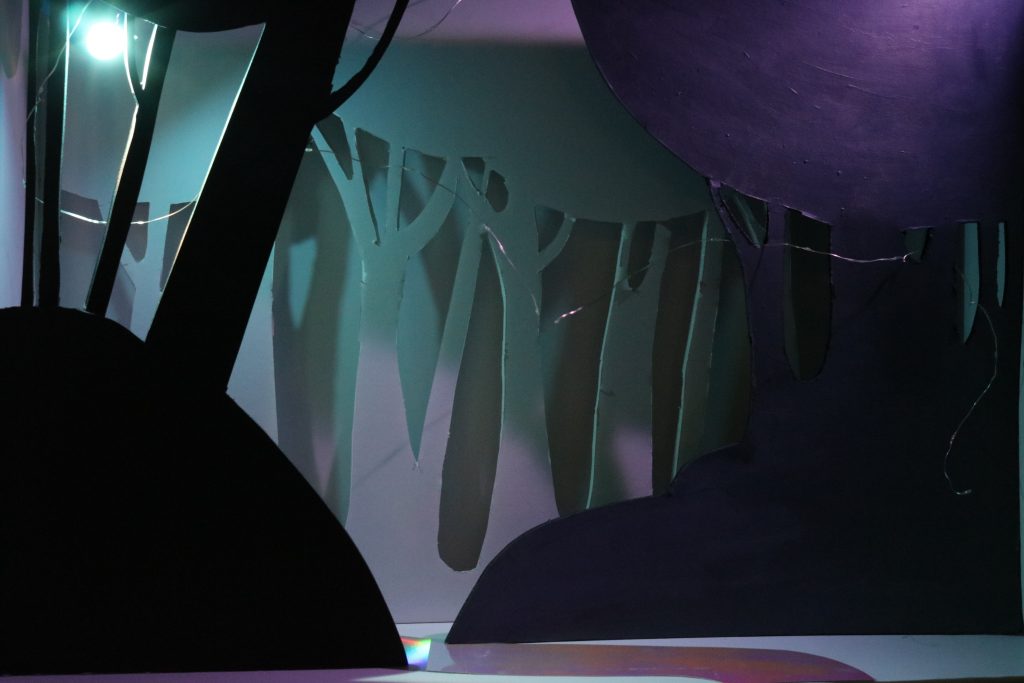
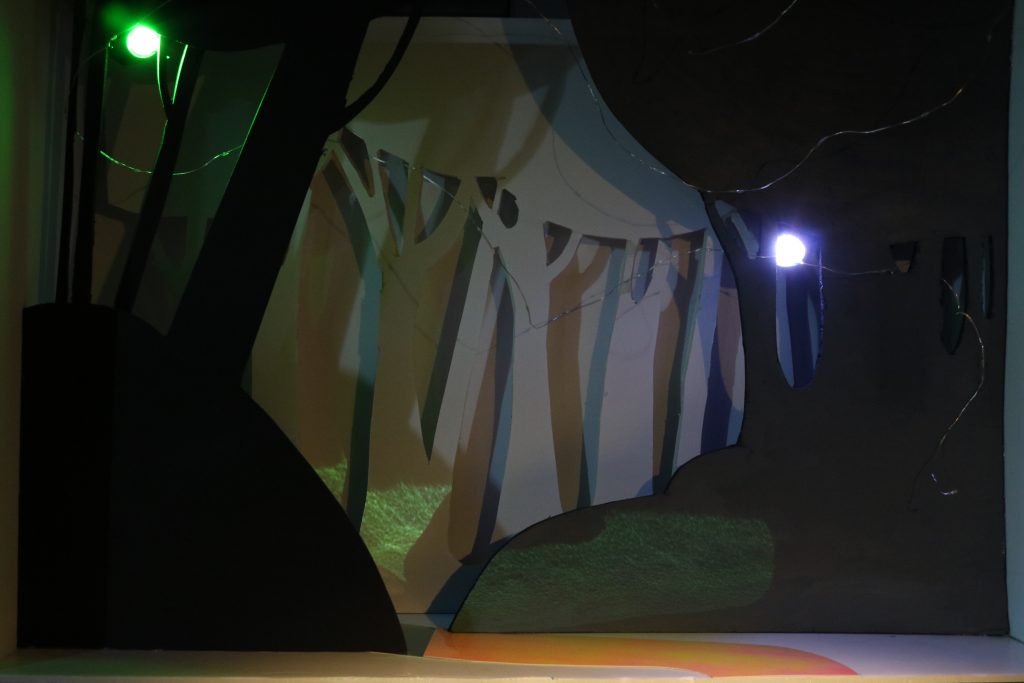
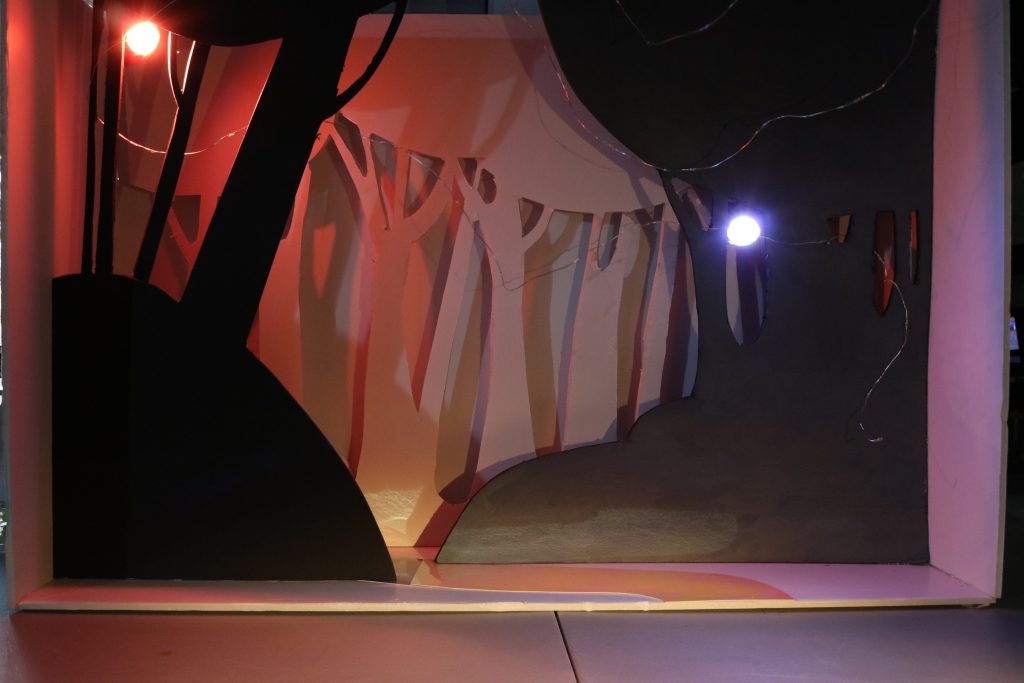
Character Design
Individually, we created characters that would eventually walk around in our mood scenes. We designed them digitally, and then made puppets of our designs.
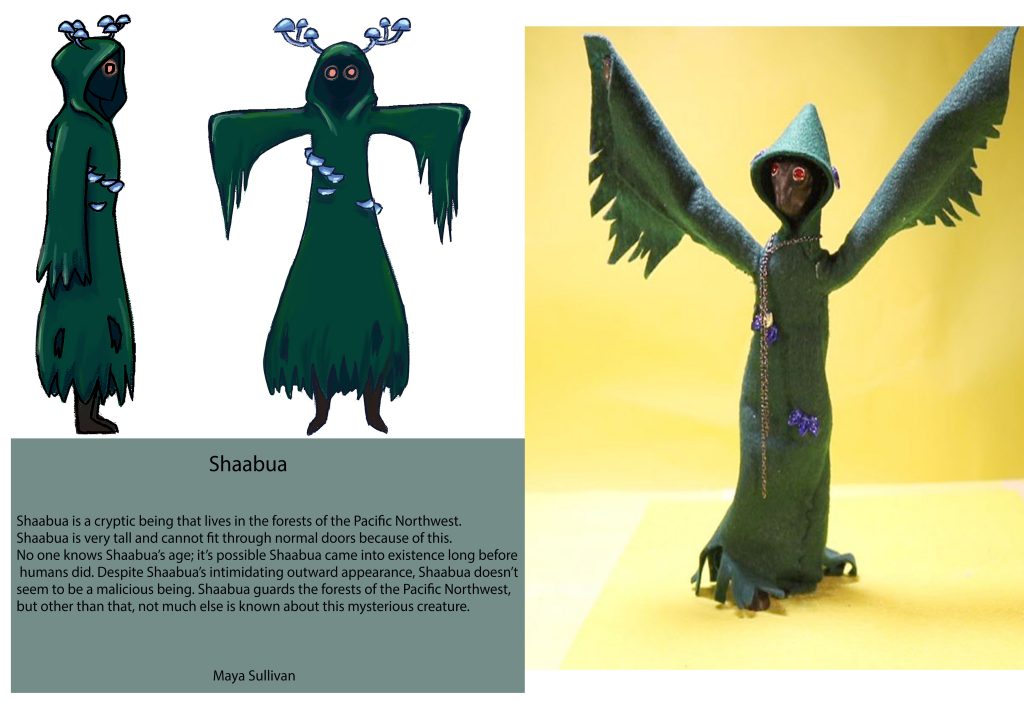
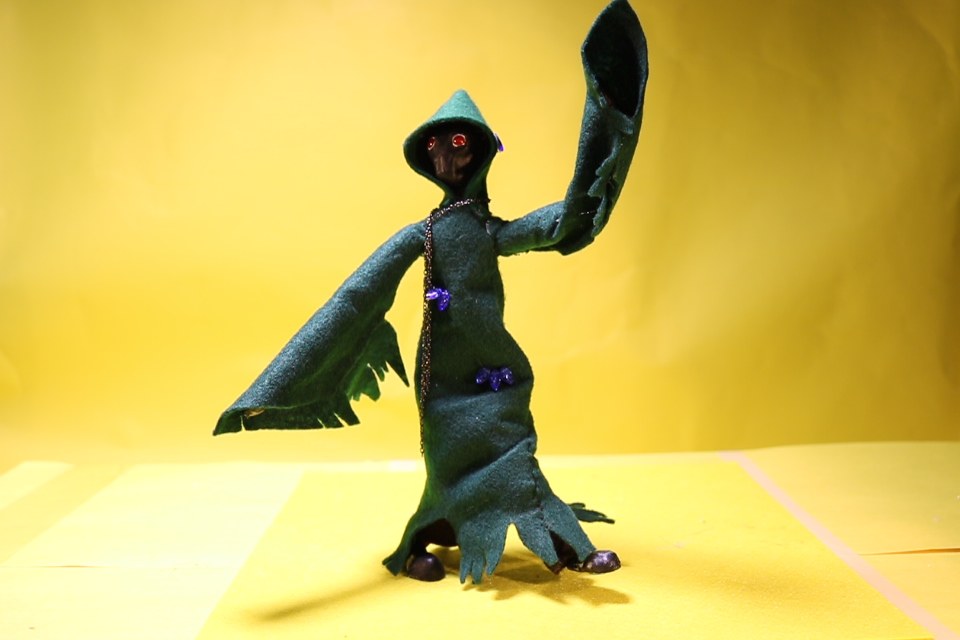
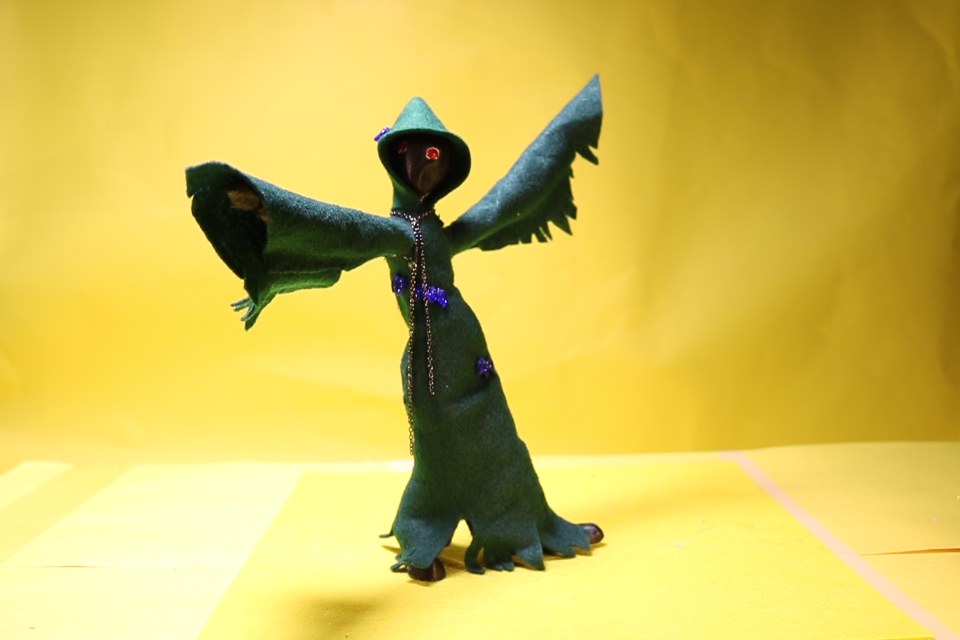
This project took a lot of time, dedication and hard work, but it was fun to see all our work come together in the end. My favorite part of creating this was working together with my friends to make our set. We all put a lot of effort into it and I’m so grateful I was able to collaborate with such amazing people. Designing Shaabua was also really enjoyable. Overall, I’m proud of the way this turned out and thankful for the skills I learned during the process of creating our mood scenes.
Illustrator Projects
In Digital Media, we learned how to use Adobe Illustrator and used our new knowledge to design a light cover and a project of our choice. I chose to design a patch.
Illustrator Choice Project: Patch


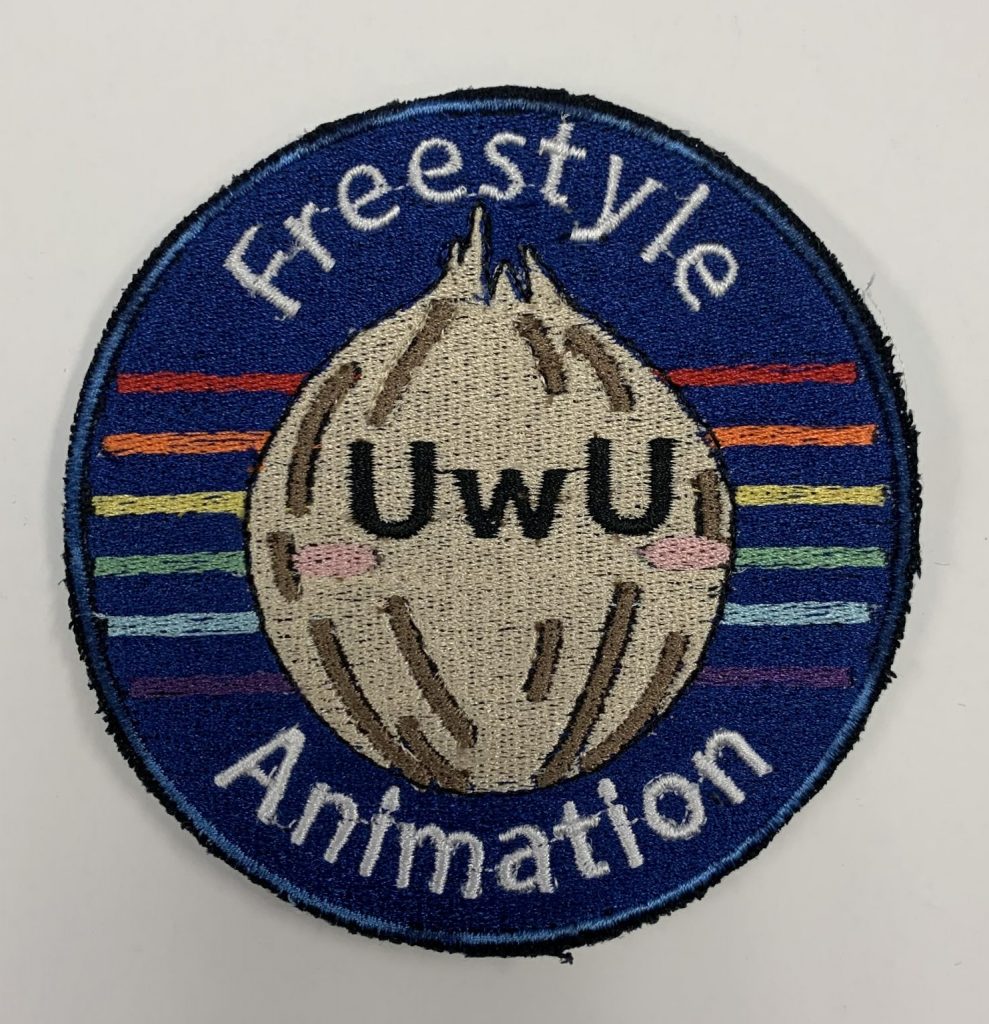
The title of my patch is “We’re the Animation Kids!” because it’s a reference to the parody song my classmates and I recently created. The inspiration for my patch came from a conversation my classmates and I were having about possible Freestyle elective mascots. The animation students that were online at the time agreed on making the mascot an onion because we use onion skins when we’re animating. It also doubles as a reference to Shrek. Many of the people in my class really enjoy Shrek. I gave the onion on my patch an “uwu” for a face because I thought it looked nice. In general, I tend to enjoy dark color pallets that have bright accent colors, so I used that color scheme for the background.
This assignment was given to us to help us practice our Illustrator skills and I feel like it helped us become better at using Illustrator. In addition to that, I also learned how to use Embrilliance to create the physical patch. We were given a lot of freedom with the designs we could create, and I’m grateful for the ability to express myself by making this patch. I appreciate the opportunity to be able to create something meaningful that I can wear and be proud of.
Geometric Light Cover
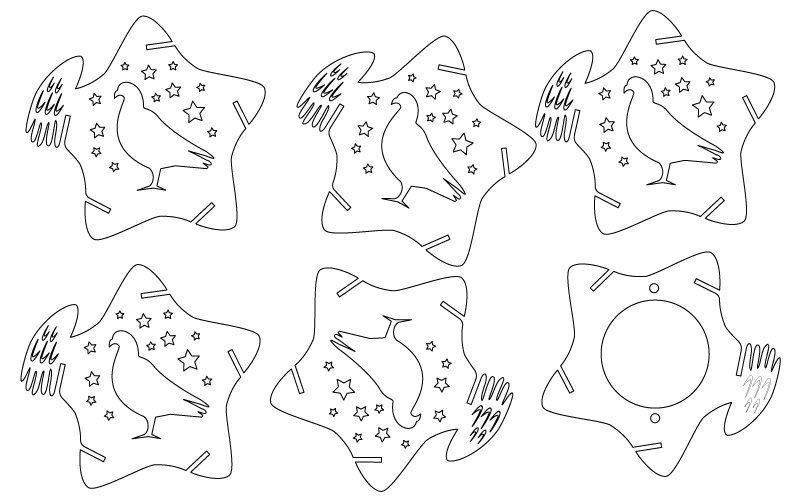
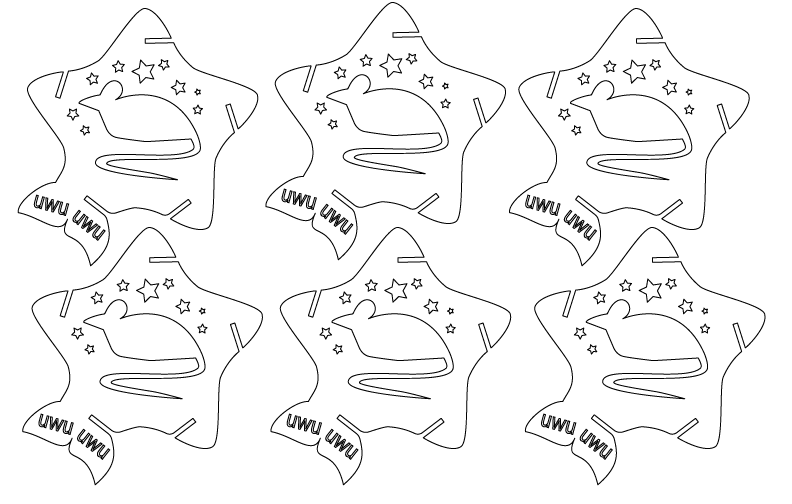
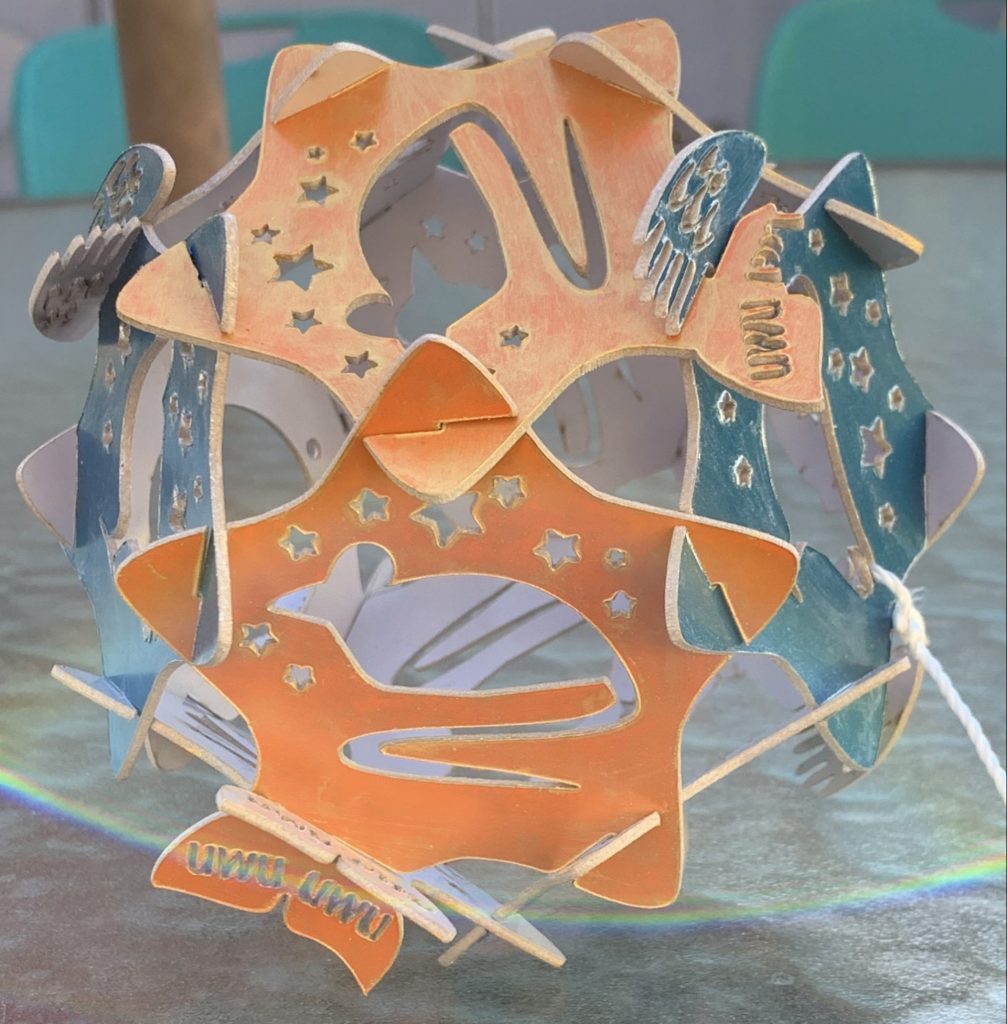
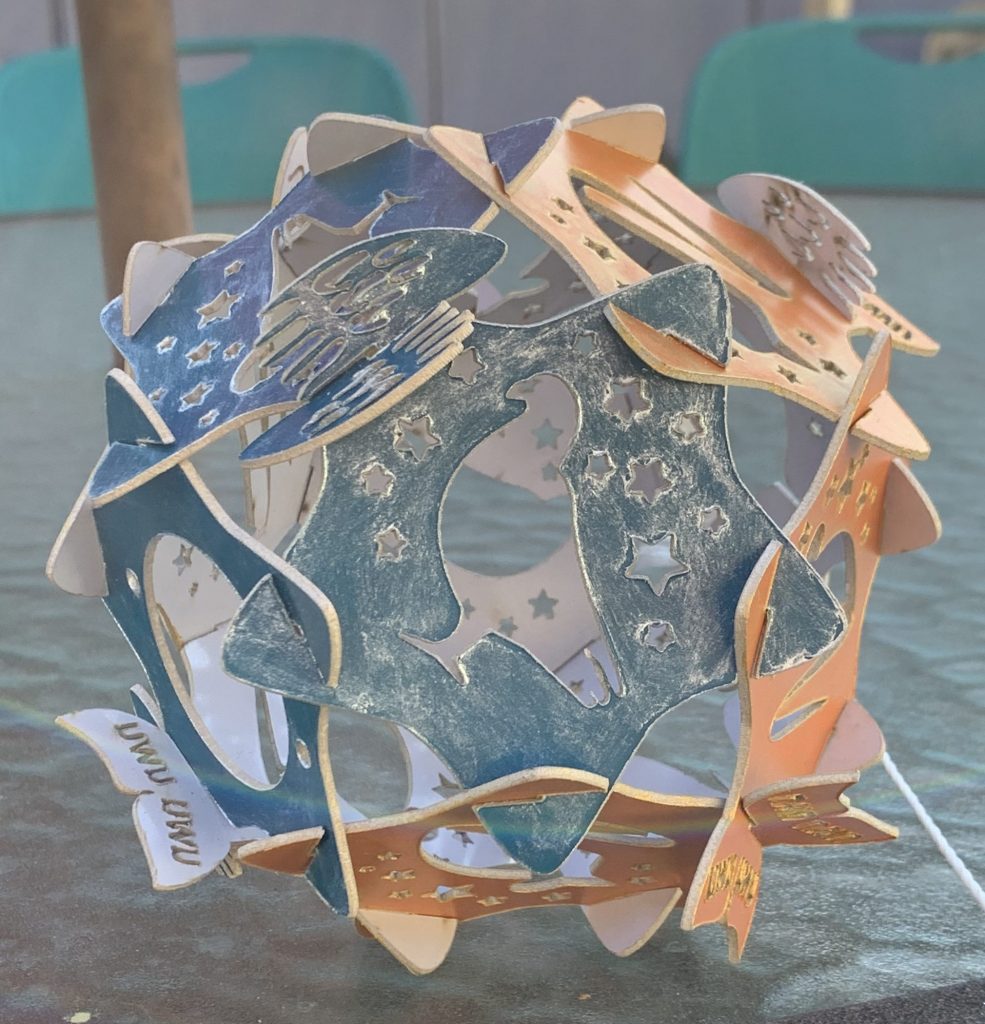
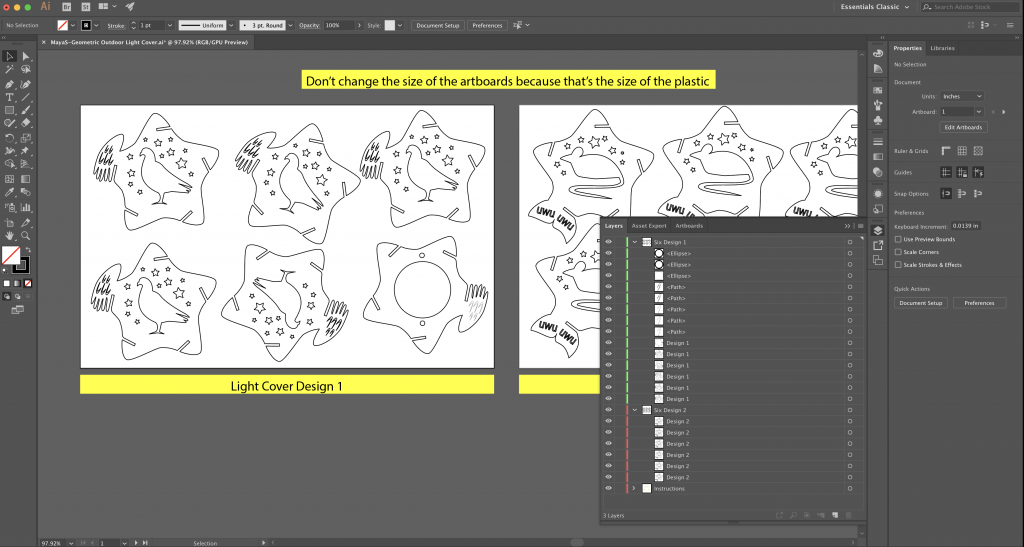
My classmates and I were given the assignment of designing a geometric light cover using Adobe Illustrator. My friends gave me the nickname “pigeon” so I decided to go with a pigeon for the first design in my geometric light cover. Pigeons are also commonly called “sky rats” so I decided to do a rat for my second design. I like stars and space themes in general, so I added some stars to both of the designs because I thought they’d look nice with the light shining through it. My favorite color is blue, so I chose blue for the pigeon design. I also painted the light cover in silver and gold to make it look shiny while also having the base colors show beneath the paint. For the interlocking parts of the design, I added wings to continue with the pigeon theme. Designing this area of the light cover was the most challenging part of the design aspect because I had to figure out how to make the wings work without obstructing the parts that would interlock together once the pieces of the light cover were assembled. I also added “uwu” to the second design because my friends and I respond to a lot of what we send to each other with “uwu”. Assembling the light cover once the designs were ready was also a bit stressful because the pieces had to be slightly bent in order to get them in the right place to interlock. In my opinion, this project was useful for learning how to practice using Adobe Illustrator to express ourselves. We were given a lot of freedom in terms of what we could choose to design, so the project allowed us to be very creative and I enjoyed that aspect of it. It was also interesting to see something that we designed digitally be turned into something 3D. Overall, what I enjoyed most about this project was creating functional art that is specific to my life in terms of the designs on it.
English Stories
In our English classes, we learned about exposition, rising action, climax, falling action, and resolution to form the plots for our own short stories. To help us develop our characters, we filled out a character questionnaire to better understand the motivations of our characters. The questionnaire also helped us describe what they look like. Afterwards, our assignment was to write a 3-5 page short story that followed the plot map we learned about.
The plot for my story was inspired by feelings of loving what you do, but fearing it may never be good enough. My character, Bongo, was inspired by the animation of a small grim reaper I did during the conceptual unit.
Dark Times
For most reapers in the underworld, the beginning of autumn means splendid times are ahead. Everyone brings back new ghosts and the underworld becomes as vibrant as the living world. However, for small reapers like Bongo, it’s an awful season. For starters, smaller reapers such as himself are tasked with bringing dead plants back to the underworld since their tiny scythes can’t handle much more than that. When autumn begins, all the plants die, and they are given a ton of work. Meanwhile, the other reapers get to guide various animals ranging from mice to lions. The most elite even have tall intricate scythes and they get to bring back humans. In other words, they get all the “cool” jobs. Bongo had been bringing dead flowers back across the veil between the living and the dead for centuries, and although he loved his job, no one ever noticed what he brought back. So this autumn, he would make sure things would be different.
The next time he had crossed through the veil between the living and the dead, he didn’t focus on the plants. As much as he enjoyed working with the great fields of lilies and roses, he needed something that could move, something active to start with. If he managed to bring back a small animal, that would make him the first of his kind to do so, and he’d never be forgotten, even long after he faded. If he were able to bring back a human, then he’d be as immortal as death himself. So he trained day after day, week after week, until he finally managed to bring back a moth. That was a difficult feat, but not impossible. No, he wouldn’t stop until he had achieved the impossible. The other reapers were starting to notice their colleague, swinging his scythe at souls twice his size like a child trying to catch butterflies in a net. Some scoffed, others shook their heads and continued on with their own jobs. But those like him, the reapers that were a few inches tall at best, equipped with scythes no larger than a pencil, noticed that the insects he had been guiding back were getting bigger and bigger with each passing night. With them, their dreams of becoming recognized grew as well. Soon, there were hundreds, then thousands of reapers that were once bringing back plants gathering to try to bring back something better. This only made Bongo more determined. They would not surpass him, he refused to even think about it. However, none of them seemed to notice that the underworld was looking more sparse than usual. The plants were starting to fade, and no one was interested in bringing back replacements. Bongo and the others continued their training in the living world, stopping in the underworld only to drop off their harvest before swiftly returning.They didn’t notice the air in the underworld getting heavier, the fog getting thicker, or the other bigger, reapers having trouble breathing. They didn’t notice the others starting to fade away as quickly as the plants were.
It was now the dead of winter, and he was still no closer to reaping a human soul. On top of that, some of the others had actually managed to bring back an animal before him. If they beat him to getting a human, then all his work would’ve been in vain. So one particularly cold December evening, he found a small infant, abandoned and alone. It is not the job of a reaper to deliver the final blow that sends a person away from the living world for eternity;, it is to sever the tie that souls have with the living world so they can be free. Even so, Bongo hesitated for a moment before raising his scythe, but he knew it was time. So he lifted his scythe to cut the silver thread that bound the child to the soil, but it bounced off the string. So he tried again, and again, and again, with each swing becoming more unstable and reckless. Any techniques he had learned in the past few months slipped away with each failed attempt. He had to beat the others to this, there was no other way. So Bongo gathered every ounce of strength he had in his 2-inch tall body and swung the scythe as hard as he possibly could. There was a flash of light, and for a fleeting moment he thought he had done it. But the string was still there, glittering in the moonlight like a spider’s web. On the ground beside it was the shattered mess that was once his scythe, scattered like a broken teacup across the concrete.
It took some time, but Bongo had managed to acquire some tape and piece together enough of his scythe to get back to the underworld. Whether or not he’d ever be able to reap anything ever again was another question. A grave one too, considering that reapers that don’t reap are purposeless, causing them to fade quickly. For a second Bongo thought he had already faded, as he didn’t recognize the underworld. There were no plants, and the fog was so thick that Bongo couldn’t see more than a foot in front of him. He almost didn’t catch the faint outlines of the other reapers around him until one reached out to tug on his robe before collapsing in exhaustion. That was when Bongo realized he had made the most dire mistake of his life. He had thought that reaping plants was useless, but it was the job that kept everyone else going. It was the job that he loved, and he gave it up for what? For fame? For prestige? Not that any of it mattered anymore since everyone was fading anyway. What was worse, he couldn’t even fix it because his scythe was broken. You’d think a reaper wouldn’t be able to cry, but for the first time in perhaps a thousand years, Bongo fell to the ground in tears.
No, no he couldn’t just lay there on the ground. Something had to be done because if it wasn’t, then it would be the end of the underworld. All the reapers would fade, and then all the dead life would become ghosts, chained to the earth forever. After a few months, there would be so many that they’d be packed together tightly enough to feel like eternal suffocation. No one deserves that for forever. It wasn’t like Bongo could just tell the others either, they’d assume he was trying to get rid of his competition. So Bongo decided he’d reverse what caused this mess in the first place and see what plants he could bring back. Then maybe if he was lucky, the others would follow.
When he arrived in the land of the living, he glanced over at his scythe. It looked like a discarded toy that had been run over by an eighteen-wheeler truck multiple times. It was a miracle that Bongo even managed to get back and forth across the veil. He hesitated before raising it to a small piece of ghost algae floating in a puddle. Since no one had been collecting plants, there were a lot of ghost plants to bring in. It had a small string attached, like the one from before but so thin that it was almost invisible, except to a reaper. This time, even though Bongo was nervous he’d break his scythe permanently, he was calm. He had done this millions of times before, the only difference was that this time, the fate of the underworld hung on the broken crescent-shaped blade of a reaper’s tiny scythe. Swish. The string was cut, leaving nothing but a faint ripple in the water behind. Bongo breathed a sigh of relief. Even if it was only algae, at least it was a start.
Once again, the other reapers stopped what they were doing and wondered why he had gone back to plants. Had he finally given up? Should they give up as well? When they returned to the underworld, they understood the issue immediately and began reaping as many plants as they could. Undoing the damage that had been done was difficult, but eventually the underworld returned to normal just in time for Spring. As the new plants bloomed in the warm breeze, Bongo was satisfied. He was only able to reap algae now, and maybe some grass with some practice, but he was grateful knowing that he had finally done something that mattered.
The End
Audio Version
Once the story was written, I recorded myself telling it and then used Avid ProTools to bring music and sound effects into it. The sound effects and the music really helped add to the overall mood of the story.
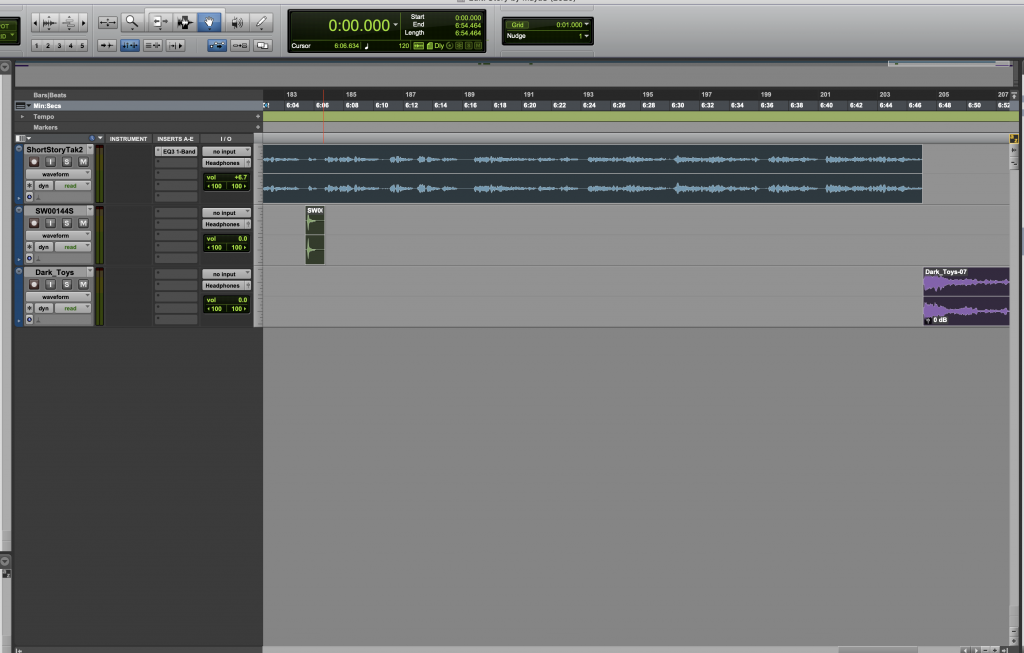
English Honors Assignment
In addition to our own story, students in English Honors were also tasked with doing an author study. We were given the option to write an emulation piece followed by an explanation on how it shows the author’s style, or an explanation piece on the author’s style. I did my study on Kurt Vonnegut and chose to write an emulation piece.
The Phoenix
The year was 2112 A.D., and the population of Earth was 16 billion. In other words, the world was about ready to burst like a bomb set to explode. The governments of the world had decided that they would solve their dilemma through exactly that- bombs. Bombs, missiles, tanks, and soldiers would be the key to solving the overpopulation problem. So every state fought everyone else. They called it The War. To keep things ethical, there were no alliances, no specific targeting of another state. There was no motivation except to destroy as much human life as possible. That way, it would simply be survival of the fittest, and Mother Nature would take care of the rest. With each building decimated, and each city flattened, and each life lost, the Phoenix would glow a little brighter.
The Phoenix was the 3,000 foot tall holographic projection of a bird rising out of the Atlantic Ocean built by the governments of the world. For approximately every 100,000 lives lost, a feather on the bird would be lit with a myriad of colors that could rival the sunrise itself. When the population hit 7 billion, it would be fully illuminated, and The War would be over. There was a smaller replica in every city, a little reminder to the citizens of the world of what The War was being fought for.
Leon looked up at city R14’s Phoenix, flickering like a candle underneath the night sky. He sighed and pulled the collar of his jacket up to shield himself against the cold. It had been 4 years, but there was still a long way to go. “Leon!” a familiar voice called out. Leon turned around to see that the voice belonged to Jacqueline, his old friend. The light of the R14 Phoenix shone across her long auburn scarf, making it appear as though she were on fire. “Are we still going to watch The War tonight?”
“Yeah I don’t see why not,” Leon replied. There was a 24/7 broadcast of The War in the center of each city, underneath the towering Phoenixes. He and Jacqueline would often join the crowd of people to watch the 30-foot wide screen display the obliteration of entire cities, which often resulted in the smoke being thick enough to block out the cameras for a few seconds. Every time a bomb went off, it was followed by the cheers of the crowd, who were almost loud enough to rival the sound of the bombs themselves. People would glance up at the Phoenix above them, expecting a feather to ignite. Generally, there was no change to the Phoenix, but on the rare occasions it did, the applause from the crowd below could be mistaken for thunder. Leon and Jacqueline made their way towards the screen just as city E79 was decimated. Jacqueline and the rest of the crowd screamed in excitement, but Leon stayed silent.
“Hey, what’s wrong? Are you alright?” Jacqueline asked. Leon’s mouth tightened into a thin line before replying.
“It’s just that, do you ever think-” he was interrupted by the annihilation of city G12, which was quickly followed by roars of joy. The screen reflected shades of orange and scarlet light from the fires of city G12 across their faces. Leon continued,
“Do you ever think it’s going to end? The War, I mean.”
“Of course it’s going to end, what else are these for?” Jacqueline gestured at the R14 Phoenix, with its wings spread elegantly across the sky.
“It’s been four years, and not even a single wing is fully ignited yet.”
“Well it’s not going to happen overnight, there’s still billions that have to die first.”
“How can we be sure we’re not part of those billions? What if we’re next? Have you ever thought about that?! If we die, not a single piece of light is going to show up on that bird! Our lives don’t matter at all any more Jacqueline! We’re going to die and it means nothing!”
“Don’t be ridiculous, state R hasn’t lost a single city yet. We-” Jacqueline was cut off by the deafening sounds of shells going off and excited screams from the crowd. She waited for the noise to die down as it normally did, but instead it seemed to be getting louder.
“Jacqueline” Leon said in a concerned voice. “Did you feel that?” Jacqueline felt the ground move beneath her black boots.
“It’s just the crowd Leon!” she shouted over the noise, which was starting to sound like very large swarm of insects. Another jolt shook the earth, and this time there was a flash of orange coming from behind both of them. Leon looked up and saw the shadowy outline of a plane glide across the sky like a hawk. Leon and Jacqueline glanced at each other and they both knew what was happening.
“Get down!” Leon shouted, before a flash of light blinded him and he lost consciousness.
When Leon awoke, his ears were ringing, and soft daylight filtered in through the pile of rubble he was laying in.
“Jacqueline,”he tried to call out, but his voice was hoarse and he could barely manage more than a whisper. He lifted the broken concrete off of himself and dusted off some soot before spotting Jacqueline’s auburn scarf sticking out from under a block of stone. He dug through the debris until he was able to drag her out and lay her on a relatively clean area of the ground.
“Jacqueline?” he gently shook her. Please Please don’t be dead he thought as tears started to form in the corners of his eyes.
“Leon?”
“Oh thank goodness you’re alive!” Leon cried out. But Jacqueline’s eyes weren’t focused on him, or on the ruins of city R14. They were staring up at the Phoenix, still hovering above the rubble like a vulture looking for prey. It was just a projection after all, any missile would just go right through it. She glanced at the remains of the city again. There was nothing but grey, broken buildings and twisted structures and smoke as far as the eye could see. She looked up at the bird again. There wasn’t a single new bright feather on the cursed thing. Jacqueline swore under her breath.
“Jacqueline? We survived, aren’t you glad?” Leon questioned.
“I think,” she paused. “I think you were right.”
“Huh?”
“You were right.” Jacqueline whispered, her gaze still fixed on the shimmering symbol of hope, floating above them in all its glory.
Explanation
In The Phoenix, I focused on mimicking the content of Vonnegut’s short stories in Welcome to the Monkey House. Many of his stories often revolve around themes involving war and overpopulation, so I decided to bring both of those themes into The Phoenix. He also tends to focus on one or two characters in the short stories dealing with external factors causing the conflict. The messages of his stories are conveyed through the dialogue between his characters, which is something I appreciated because it made the characters feel more real while also emphasizing exactly what Vonnegut wanted the audience to focus on.
Vonnegut’s introductions to his stories are either a detailed description of his characters or his setting, which help readers gain a better sense of the environment the characters are in, since many of Vonnegut’s stories take place in different time periods. In Harrison Bergeron, the story begins with “The year was 2081, and everybody was finally equal. They weren’t only equal before God and the law. They were equal in every which way. Nobody was smarter than anybody else. Nobody was better looking than anybody else. Nobody was stronger or quicker than anybody else.” (Vonnegut 7). The opening line lets the readers know that this society is futuristic, and the equality conflict is immediately set up as well through the use of repetition, letting readers know the differences between our world and Vonnegut’s world. The short, matter-of-fact sentences help solidify the concept of this society’s equality in the readers’ minds. By doing this, Vonnegut helps readers better visualize the world he’s created. In Welcome to the Monkey House, Vonnegut fills the exposition with new terms and a vivid description of the setting. For example, “a notorious nothinghead named Billy the Poet was believed headed for the Cape. A nothinghead was a person who refused to take his ethical birth-control pills three times a day. (…) So the World Government was making a two-pronged attack on overpopulation. One pronging was the encouragement of ethical suicide (…) the other pronging was compulsatory ethical birth control.” (30) Through his description, Vonnegut is able to illustrate what this world is like and highlight the major differences between the world we know and this world. In addition, he used the connotations of words such as “ethical” and “suicide”, and “compulsatory ethical” to create juxtaposition, causing readers to pause and question the morals of this society. In the exposition to The Phoenix I attempted to follow a similar structure to Harrison Bergeron and Welcome to the Monkey House by stating exactly how and what the world is composed of with matter-of-fact sentences and imagery. I also tried to follow Vonnegut’s satirical style by using words like “ethical” and “glow brighter” in the middle of a description about a massive ongoing war.
A trend in Vonnegut’s stories is for the story to be moved by the dialogue between the characters. In Tomorrow and Tomorrow and Tomorrow, the character Emerald expresses her frustration at having a substance that stops people from aging. “Sometimes I wish there wasn’t any such thing as anti-gerasone! (…) Sometimes I wish folks just up and died regular as clockwork, without anything to say about it, instead of deciding themselves how long they’re going to stay around. There should be a law against selling the stuff to anybody over one hundred and fifty.”(317) What Emerald is describing is a world like our own, which makes readers pause and appreciate our world for a moment. Although aging is scary to think about, through Emerald’s frustration, Vonnegut warns against having a way to make people stop aging because the world would become too overpopulated, leading to quality of life decreasing immensely. In Welcome to the Monkey House, Nancy and Billy the Poet have a conversation about what a person’s life means in terms of making the population decrease. “‘Tell me-’ he said, ‘when I die, how much will that thermometer go down? A foot?’ ‘No.’‘An inch?’ ‘Not quite.’ ‘You know what the answer is don’t you?’he said, and he faced her. The senility had vanished from his voice and eyes. ‘One inch on that thing equals 83,333 people. You knew that, didn’t you?’” (Vonnegut 39). Using the imagery of the thermometer and the dialogue between Nancy and Billy emphasizes how little a person’s life means in this world. I attempted to mimic this in my own writing with the use of the giant phoenix structures hovering around the cities for imagery, and the dialogue between Leon and Jaqueline to drive home the themes of this story. The insignificance of human life when overpopulation gets out of control was one of Vonnegut’s main concerns that he focused on when writing his stories, so I followed that pattern with The Phoenix.